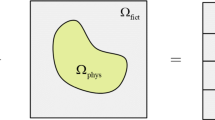Abstract
In this paper, the analytical displacement solution at the point of the application of a concentrated force is derived using elastic mechanics. Then, the concentrated-force asymptotic function is obtained. Next, by introducing the concentrated-force asymptotic functions into finite element analysis, a method of simulating concentrated forces is developed. The proposed method can obtain an accurate stress field without any mesh refinement at the point of the application of a concentrated force. Meanwhile, the proposed method has considered the effect of the direction of the concentrated forces. The numerical tests reveal that the proposed method is convergent, accurate and feasible for obtaining satisfactory results.












Similar content being viewed by others
References
Zhang J, Wang B, Niu F, Cheng G (2015) Design optimization of connection section for concentrated force diffusion. Mech Based Design Struct Mach 43(2):209–231
Zhang A, Du JL, Guo ZP, Wang QG, Xiong SM (2019) Conservative phase-field method with a parallel and adaptive-mesh-refinement technique for interface tracking. Phys Rev E. https://doi.org/10.1103/PhysRevE.100.023305
Sarkar S, Singh IV, Mishra BK (2020) Adaptive mesh refinement schemes for the localizing gradient damage method based on biquadratic-bilinear coupled-field elements. Eng Fract Mech. https://doi.org/10.1016/j.engfracmech.2019.106790
Funken SA, Schmidt A (2020) Adaptive mesh refinement in 2D—an efficient implementation in MATLAB. Comput Meth Appl Math 20(3):459–479. https://doi.org/10.1515/cmam-2018-0220
Dong YY, Yuan S, Xing QY (2019) Adaptive finite element analysis with local mesh refinement based on a posteriori error estimate of element energy projection technique. Eng Comput 36(6):2010–2033. https://doi.org/10.1108/Ec-11-2018-0523
Baiges J, Codina R, Castanar I, Castillo E (2020) A finite element reduced-order model based on adaptive mesh refinement and artificial neural networks. Int J Numer Methods Eng 121(4):588–601. https://doi.org/10.1002/nme.6235
Antepara O, Balcazar N, Oliva A (2020) Tetrahedral adaptive mesh refinement for two-phase flows using conservative level-set method. Int J Numer Methods Fluids. https://doi.org/10.1002/fld.4893
Kittur MG, Huston RL (1990) Finite-element mesh refinement criteria for stress-analysis. Comput Struct 34(2):251–255. https://doi.org/10.1016/0045-7949(90)90368-C
Khattri SK (2007) Grid generation and adaptation by functionals. Comput Appl Math 26(2):235–249
Davim JP (2017) Computational methods and production engineering: research and development. Elsevier Science, Amsterdam
Tu J, Yeoh GH, Liu C (2018) Computational fluid dynamics: a practical approach. Elsevier Science, Amsterdam
Sadd MH (2014) Elasticity: theory, applications, and numerics. Elsevier Science, Amsterdam
Rees DWA (2018) Mechanics of elastic solids. World Scientific Publishing Company, Singapore
Murakami Y (2016) Theory of elasticity and stress concentration. Wiley, New York
Timoshenko S, Goodier JN (1969) Theory of elasticity. McGraw-Hill, New York
Khoei AR (2015) Extended finite element method: theory and applications. Wiley, New York
Mohammadi S (2008) Extended finite element method: for fracture analysis of structures. Wiley, New York
Chen JW, Zhou XP, Berto F (2019) The improvement of crack propagation modelling in triangular 2D structures using the extended finite element method. Fatigue Fract Eng Mater 42(2):397–414. https://doi.org/10.1111/ffe.12918
Zhou XP, Chen JW (2019) Extended finite element simulation of step-path brittle failure in rock slopes with non-persistent en-echelon joints. Eng Geol 250:65–88. https://doi.org/10.1016/j.enggeo.2019.01.012
Chen JW, Zhou XP (2019) The enhanced extended finite element method for the propagation of complex branched cracks. Eng Anal Bound Elem 104:46–62. https://doi.org/10.1016/j.enganabound.2019.03.028
Zhou XP, Chen JW, Berto F (2020) XFEM based node scheme for the frictional contact crack problem. Comput Struct. https://doi.org/10.1016/j.compstruc.2020.106221
Chen JW, Zhou XP, Zhou LS, Berto F (2020) Simple and effective approach to modeling crack propagation in the framework of extended finite element method. Theor Appl Fract Mech 106:102452. https://doi.org/10.1016/j.tafmec.2019.102452
Tada H, Paris PC, Irwin GR (2000) The Stress Analysis Of Cracks Handbook, 3rd edn. ASME Press, New York. https://doi.org/10.1115/1.801535
Belytschko T, Black T (1999) Elastic crack growth in finite elements with minimal remeshing. Int J Numer Methods Eng 45(5):601–620. https://doi.org/10.1002/(Sici)1097-0207(19990620)45:5%3c601::Aid-Nme598%3e3.0.Co;2-S
Acknowledgements
The work is supported by the National Natural Science Foundation of China (nos. 52027814, 51839009, 51679017).
Author information
Authors and Affiliations
Corresponding author
Additional information
Publisher's Note
Springer Nature remains neutral with regard to jurisdictional claims in published maps and institutional affiliations.
Rights and permissions
About this article
Cite this article
Chen, J., Zhou, X., Yao, W. et al. A novel method for accurate simulations of concentrated forces in finite element analysis. Engineering with Computers 38, 2791–2803 (2022). https://doi.org/10.1007/s00366-020-01239-w
Received:
Accepted:
Published:
Issue Date:
DOI: https://doi.org/10.1007/s00366-020-01239-w




